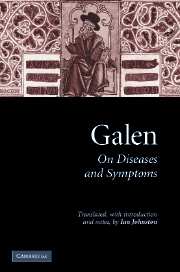Book contents
- Frontmatter
- Contents
- List of tables
- Acknowledgements
- List of abbreviations
- PART I INTRODUCTION
- PART II TRANSLATION
- II.0 Introduction
- II.1 On the Differentiae of Diseases
- II.2 On the Causes of Diseases
- II.3 On the Differentiae of Symptoms
- II.4 On the Causes of Symptoms I
- II.5 On the Causes of Symptoms II
- II.6 On the Causes of Symptoms III
- PART III CONCLUSION
- Bibliography
- Index
II.4 - On the Causes of Symptoms I
Published online by Cambridge University Press: 22 September 2009
- Frontmatter
- Contents
- List of tables
- Acknowledgements
- List of abbreviations
- PART I INTRODUCTION
- PART II TRANSLATION
- II.0 Introduction
- II.1 On the Differentiae of Diseases
- II.2 On the Causes of Diseases
- II.3 On the Differentiae of Symptoms
- II.4 On the Causes of Symptoms I
- II.5 On the Causes of Symptoms II
- II.6 On the Causes of Symptoms III
- PART III CONCLUSION
- Bibliography
- Index
Summary
SYNOPSIS
I.1 A statement of aim – to examine causes of symptoms based on previously stated classificatory divisions.
II.1 Starting with sensory functions, the eye is taken as the first example. There is a threefold division: (i) the primary organ of sensation (crystalloid); (ii) the sensory capacity passing from brain to eye via the optic nerve; (iii) other, subsidiary parts of the eye. Diseases of the eye are to be understood by applying previous classifications to these three structural components.
II.2 Predominantly about the pupil, its relationship to the sensory pneuma presumed to flow via the optic nerve, and variations in pupillary size dependent on this flow. The prediction of outcome in couching of cataract is also considered.
II.3 More on the pupil, together with discussion of what is presumed to be the aqueous humour and its role in protecting the eye from the adverse effects of bright light.
II.4 Mainly about diseases of the choroid, including dissolution of continuity.
II.5 Galen returns to disturbances of the aqueous humour and the symptoms produced by these.
II.6 On eye symptoms arising from disturbances elsewhere in the body.
II.7 Brief consideration of ‘sympathetic’ affections of vision, and also of the general correspondence of the severity of symptoms to the magnitude of disturbance.
II.8 A summary of the effects of changes in the psychic pneuma on vision.
II.9 Disturbances of the cornea, including penetrating injuries, and their effects on vision.
II.10 A very brief statement about disorders of the conjunctiva and the eyelids. […]
- Type
- Chapter
- Information
- Galen: On Diseases and Symptoms , pp. 203 - 235Publisher: Cambridge University PressPrint publication year: 2006



